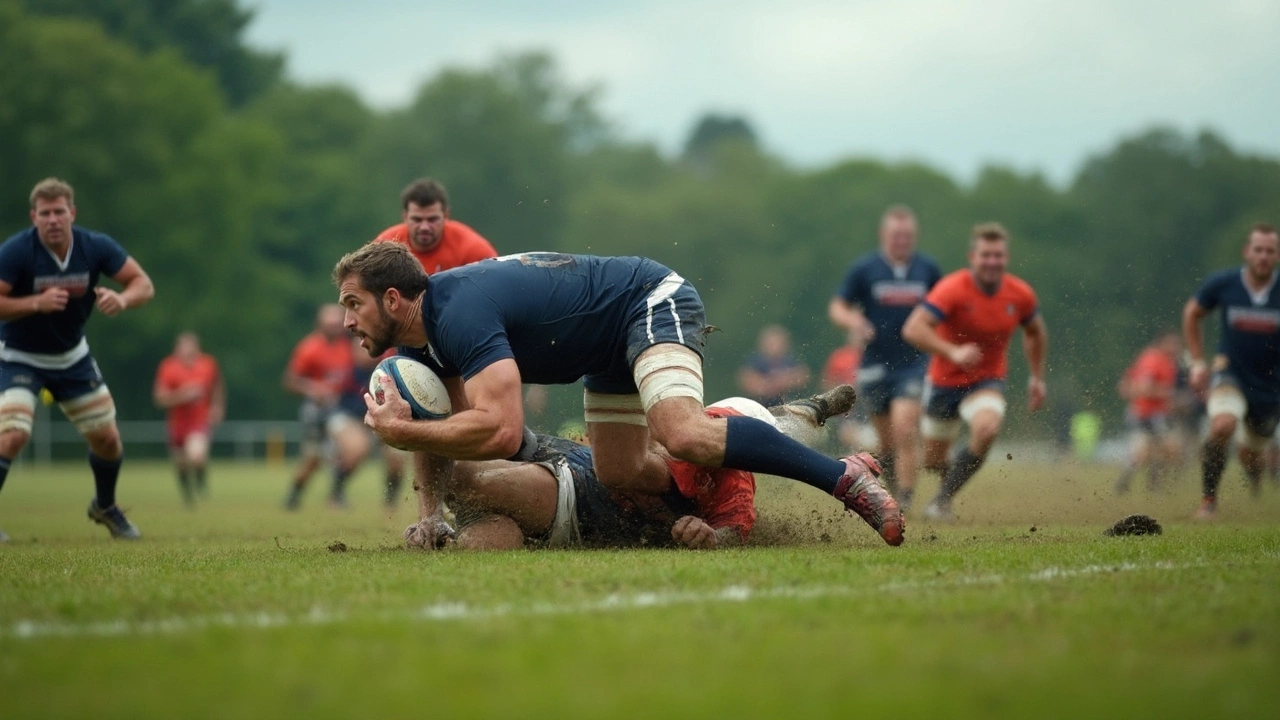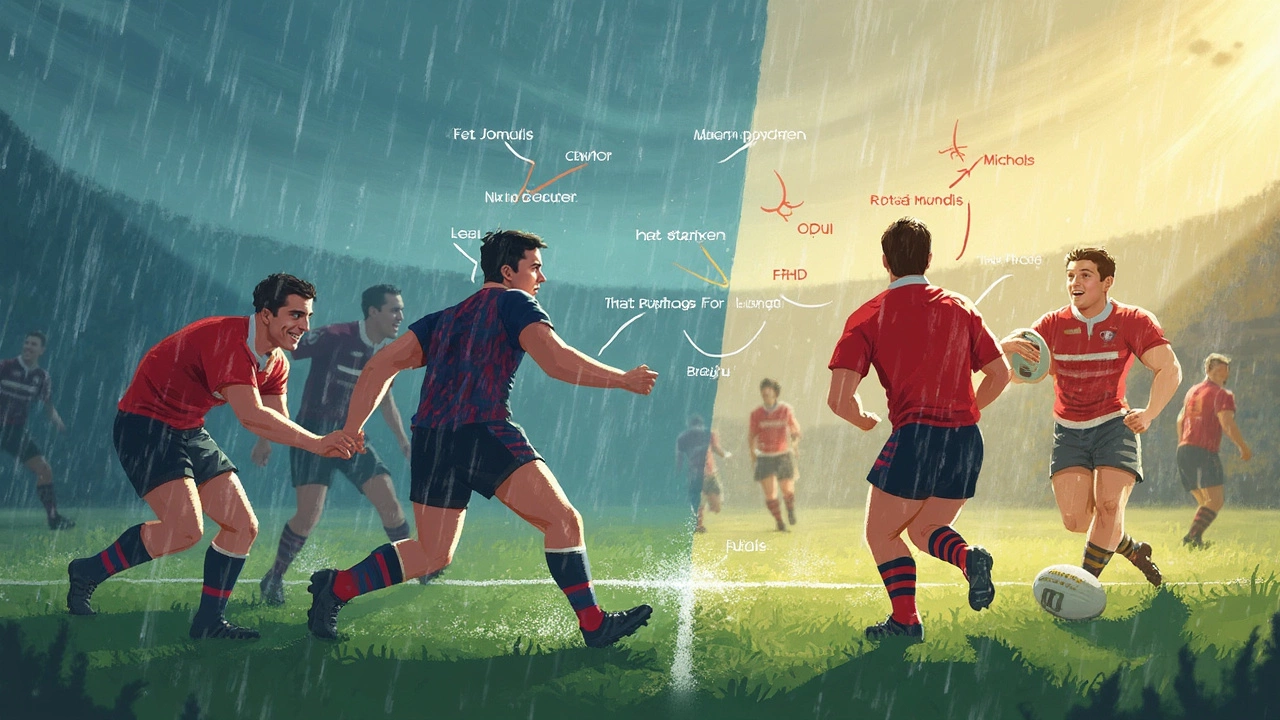Jackal in Rugby: What It Means and Why It Matters

If you've ever heard commentators yell, "He’s jackaled it!" and had no clue what was happening, you're definitely not alone. The word ‘jackal’ in rugby doesn’t mean there’s a wild animal on the pitch. Nope—it’s all about stealing possession right after a tackle. It’s one of the gutsiest, smartest things a player can do during a game, but also one of the hardest to get right. And believe me, when someone nails a jackal, the cheers from their teammates say it all.
The jackal comes into play the second a tackler and ball-carrier hit the ground. While most eyes swear the tackle is the big show, the real magic kicks off when someone dives in over the tackled player, tries to get their hands on the ball, and looks to poach it before a ruck is fully formed. Pulling it off legally? That’s tricky. Every millisecond matters, because if you’re too slow or sloppy, you’ll give away a penalty, not win possession.
- What is a Jackal in Rugby?
- How the Jackal Works in a Match
- Jackaling Techniques and Tips
- Risks and Penalties: What Goes Wrong
- Famous Jackals and the Impact on Results
What is a Jackal in Rugby?
A jackal in rugby is when a defender steals the ball right after making a tackle, before a ruck properly forms. It’s one of the best ways to turn defense into attack within seconds. The word gets tossed around a lot in commentary, and for good reason—a successful jackal can stop the other team’s momentum in its tracks.
Here’s how it works: once the tackle is made and the ball carrier is on the ground, a player from the defending team (often a flanker or hooker) quickly gets to their feet and tries to get hands on the ball while staying upright. If they do it well and legally, they can rip the ball away, buying a turnover for their team.
The key is speed and body position. According to World Rugby’s law 14, a player can contest for the ball after a tackle as long as they stay on their feet, come in from the right direction, and don’t use their hands once a ruck forms. Mess up any of that? Penalty against you. So, jackaling is as much about brains as it is about bravery.
"The best jackalers are the ones who can read the breakdown, time their entry perfectly, and get out before the referee’s whistle," says former Wales captain Sam Warburton in ‘Open Side: My Life in Rugby’.
The move gets its wild name because the player looks just like a jackal in the wild—quick, sneaky, and always waiting to pounce on a loose ball. In men’s rugby, you’ve probably seen players like David Pocock or Maro Itoje pull this off. In women’s rugby, Emma Taylor has built a rep as one of the top at this skill.
This isn’t just a party trick. A jackal can break up an opponent’s attack and instantly flip the script, putting your team on the front foot. Pretty much every top coach trains their players in jackaling now—especially after the new breakdown rules made it both riskier and more rewarding if you get it right.
How the Jackal Works in a Match
The basics are pretty straightforward: once a tackle happens, the tackler or another defender gets to their feet, stays onside, and tries to grab the ball before a ruck forms. The player doing this is called the jackal. Their main aim? Rip the ball away for a quick turnover. A clean jackal can shift momentum instantly and has decided plenty of big matches—just ask fans of turnovers late in a tight Test game.
The referees are watching everything closely now, too. Since the World Rugby law tweaks in 2020, only the first arriving player, arriving legally, can go for the jackal. The jackal has to support their own body weight and not put hands down on the ground. If you lean on the turf for balance, you're risking a penalty. Head over the ball, feet planted, hands on the ball—that’s what refs want to see. Mess that up, and you’ll have everyone glaring at you after you give away a silly penalty.
- Entry angle matters: Come in from the side, and it’s a penalty for "side entry." Always go straight through the gate behind the tackled player.
- Timing is everything: The best jackals are super quick. Arrive too slow and you’ll just join the ruck; arrive too soon and you’ll be offside or get cleaned out by opposition.
- Body position: Big, strong legs, sturdy core, low stance—think of players like Michael Hooper or Tom Curry, who seem glued to the spot once they lock in.
Some stats from the 2023 Rugby World Cup show just how big an impact jackals can have. Here’s a quick look at turnover rates from top performing countries:
| Country | Jackal Turnovers per Game |
|---|---|
| New Zealand | 3.8 |
| South Africa | 4.1 |
| England | 3.3 |
| France | 3.5 |
These turnovers don’t always lead to points, but they stop attacks and frustrate opponents—especially late in the game when everyone’s exhausted. So next time you’re watching and see someone camped over the ball after a tackle, you’ll know what’s really going on and why their teammates are losing their minds if it works.

Jackaling Techniques and Tips
Getting the jackal right takes way more than just guts. There’s a set of key moves that top players use every time. First big thing: you have to get to your feet as soon as you’ve tackled someone. The rules are clear—you can’t go for the ball unless you’re supporting your own weight on your feet and coming in through the gate. That just means entering straight, not from the side. Referees are strict, and if you mess that up, you risk a penalty.
Once you’re over the ball, you want to get your hands on it—fast, but clean. Grabbing at the ball carelessly will get you nowhere. The best jackalers, like Michael Hooper or Tom Curry, keep their hips low, knees bent, and eyes glued to the ball. Balance is everything. If you’re off balance, you’ll be shifted by even the smallest support player.
- Focus on speed: The longer you wait, the more likely the ruck forms and your chance is gone.
- Stay strong: Plant your feet, lower your hips, and keep your center of gravity over the ball so you can’t be pushed off easily.
- Keep your head up (literally): Heads too low risk neck injuries. Good technique means solid protection for yourself.
- Grip with purpose: You only have a split second to latch onto the ball, so go for the middle, not the edges.
- Read the ref: If the whistle goes, let go! Penalties for holding on are one of the most common in rugby.
Debuting players often overlook communication. A quick call from teammates can highlight if support is coming or if it’s time to bail before getting cleared out hard. Jackaling isn’t worth busting a shoulder over.
Want to know how much of a difference good technique makes? Look at how jackal turnovers changed World Cup matches since 2019. Stats show that teams winning more turnovers at the breakdown usually top the leaderboard:
| Team | Avg. Jackal Turnovers (per match) | 2019 World Cup Finish |
|---|---|---|
| South Africa | 6 | Champions |
| England | 5 | Runners-up |
| New Zealand | 4 | 3rd Place |
The takeaway? Honing your jackal skill doesn’t just impress coaches—it wins games. Train for quick reactions, proper posture, and never skip a chat with your mates on the field. These details are what turns good players into legends at the breakdown.
Risks and Penalties: What Goes Wrong
Going for the jackal sounds like a cool move, but it’s loaded with risk if you mess up the details. Some of the best players have been penalized or even injured for getting it wrong. The most common thing that ruins a jackal is not releasing the tackled player before competing for the ball. Referees will ping you for that every time.
There’s also a rule about staying on your feet. If your knees touch the ground or you dive in, expect the whistle. Most turnovers that get called back are because the would-be jackaler lost balance and ended up off their feet. And don’t get caught coming in from the side—referees are strict here, and that’s a super easy penalty for your opponent.
- Not releasing the tackled player
- Not supporting your own weight (going off feet)
- Entering from the side
- Hands in after the ruck forms
Besides losing a chance at the ball, penalties for a bad jackal can flip the momentum instantly. A penalty inside your half can put your team on the back foot and lead to points against you. Even worse, repeat offenders risk a yellow card and ten minutes off the pitch—that’s huge in a tight game. World Rugby reported in 2024 that jackaling errors made up about 17% of all ruck penalties at the last men’s World Cup.
| Common Jackal Penalty | Percentage at 2023 World Cup |
|---|---|
| Not releasing | 42% |
| Off feet | 31% |
| Side entry | 21% |
| Other (hands in ruck, etc.) | 6% |
Finally, jackaling puts your neck and shoulders in the firing line. Don’t be surprised to see pro players wearing extra padding or spending loads of time on build-up exercises for their upper bodies. If you play, practice safe technique and stay alert for cleaners flying in from the other team. Rugby laws are updated regularly to protect jackalers, but you still need to look after yourself and follow the rules to avoid injuries and repeated penalties.

Famous Jackals and the Impact on Results
When you think of jaw-dropping jackal moves, certain players pop up right away. David Pocock, the former Aussie flanker, is a legend when it comes to the jackal. Back in the 2015 Rugby World Cup, he completely frustrated teams by turning over rucks almost single-handedly—his jackal against Wales in the pool stages literally saved Australia from conceding late tries, and folks still talk about it today. During that run, Pocock won more turnovers than any other player in the tournament.
Over in the Northern Hemisphere, nobody does it quite like Ireland’s Josh van der Flier or England’s Tom Curry. At the 2023 Six Nations, van der Flier’s game-changing turnovers were key in Ireland’s Grand Slam win. That famous weekend against England? He jackaled three critical balls in their 22, stopping attacks dead and swinging momentum straight back to Ireland. Curry’s jackaling stats in the 2019 World Cup helped England control games against both Australia and New Zealand—with the turnover count showing just how those small wins at the breakdown translate to big results on the scoreboard.
South Africa’s Kwagga Smith is another name you can’t ignore. His blitz-quick reactions and low body position see him nabbing turnovers when the pressure's highest. In the 2023 Rugby Championship decider, Smith's jackal in the dying minutes secured possession and, basically, the title. Teams plan entire game strategies around either using or avoiding players like him.
If you check out most big upsets in recent World Cups or Championships, you’ll notice a pattern: the team that wins more turnovers from jackaling usually gets a bunch more scoring chances. That link between turnovers and results is no accident—it’s about shifting control and putting yourself on the front foot. Coaches are now spending dedicated training time drilling jackal technique, not just with forwards but backs too, because one clean jackal can flip an entire match.
